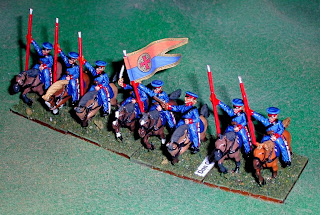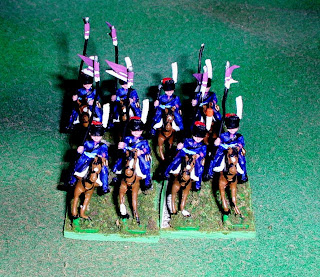Certainly nothing shouts out "The Russians are Coming" like a swarm of Cossacks! These notorious irregular horsemen were the border guards of the Russian Empire, stationed in territories ("voiskos") bordereing the Turks or Eastern tribes. The regulation dress of the Cossacks (and other irregular forces) during the Naopleonic Wars is described in detail in Viskovatov volume 18, as translated by Mark Conrad; this volume also has a surprisingly large and detailed amount of information about the standards and flags of the Cossacks, Oplochenie, etc.
The most numerous of the Cossacks by far were the Don Cossacks. There were 80 regiments (called "pulks") each composed of 5 squadrons (or "sotnias") of 100 men, thus yielding 500 men per regiment, at least theoretically. The Ataman's regiment could be doubled in wartime. There were also 3 horse batteries. Over the course of the Napoleonic wars, the regulation dress of the various other Cossacks generally came to more closely resemble those of the Don Cossacks. Period descriptions leave little doubt that regulation dress was the exception rather than the rule when these rapacious light cavalrymen took to the field on campaign.
The Bug Cossacks were raised in 1803 (3 Pulks), as well as the Black Sea Cossacks (10 pulks each foot and mounted), and Orenburg Cossacks (1 pulk of 10 sotnias). These were followed by the Stavropol Kalmuks (10 sotnias). In 1805, 10 pulks of Orel (Ural) Cossacks were added, and in 1807 1 pulk each of Evpatorski, Perekopski, Simferopolsi, and Feodorsiiski Cossacks (per Nafziger), plus a pulk of Crimean Tartars. In 1808, 10 sotnias (and 2 horse artillery batteries) of Siberian Cossacks were added. In 1812 four pulks were raised from the Ukraine, but these ultimately became Uhlans, and another 15 pulks were raised from Little Russia. Finally, in 1811 there were 2 pulks each of Kalmucks and Bashkirs raised, with 18 more pulks of Bashkirs raised in 1814, although they were disbanded the following year. Thus, by the end of the Napoleonic wars, there were, at least in theory, as many as 75,000 of these irregular horsemen serving with the Russian army in one capacity or another!
The most numerous of the Cossacks by far were the Don Cossacks. There were 80 regiments (called "pulks") each composed of 5 squadrons (or "sotnias") of 100 men, thus yielding 500 men per regiment, at least theoretically. The Ataman's regiment could be doubled in wartime. There were also 3 horse batteries. Over the course of the Napoleonic wars, the regulation dress of the various other Cossacks generally came to more closely resemble those of the Don Cossacks. Period descriptions leave little doubt that regulation dress was the exception rather than the rule when these rapacious light cavalrymen took to the field on campaign.
The Bug Cossacks were raised in 1803 (3 Pulks), as well as the Black Sea Cossacks (10 pulks each foot and mounted), and Orenburg Cossacks (1 pulk of 10 sotnias). These were followed by the Stavropol Kalmuks (10 sotnias). In 1805, 10 pulks of Orel (Ural) Cossacks were added, and in 1807 1 pulk each of Evpatorski, Perekopski, Simferopolsi, and Feodorsiiski Cossacks (per Nafziger), plus a pulk of Crimean Tartars. In 1808, 10 sotnias (and 2 horse artillery batteries) of Siberian Cossacks were added. In 1812 four pulks were raised from the Ukraine, but these ultimately became Uhlans, and another 15 pulks were raised from Little Russia. Finally, in 1811 there were 2 pulks each of Kalmucks and Bashkirs raised, with 18 more pulks of Bashkirs raised in 1814, although they were disbanded the following year. Thus, by the end of the Napoleonic wars, there were, at least in theory, as many as 75,000 of these irregular horsemen serving with the Russian army in one capacity or another!
This pulk of Cossacks I haven't designated as any one particular type, and they wear a mix of regulation dark blue and various home dyed brown clothing. The long coat is termed a Kaftan, and was very baggy, allowing many layers of clothing to be worn underneath it as protection from the frigid Russian winter... certainly a practical arrangement! For these fellows, I deliberately made their mounts as non uniform as possible, as befitting a highly irregular force!
Another view; these figures were just completed by me, and are 28mm Essex. The standard is by GMB, and of the pattern for the Black Sea Cossacks. I will probably call these Bug Cossacks, though. After all, it is their job to harass the enemy, so most players find that the enemy's Cossacks bug them (sorry!).
If you're a French player, this is the view of Cossacks that you prefer to see! Cossacks were fierce and hardy, but undisciplined, and especially disliked facing Artillery - can't say as I can really blame them there!
By comparison, these are some very old (25+ years) 25mm Don Cossacks by Minifigs from my collection. They are in pretty much regulation uniform - dark blue kaftan with red facings, which became universal in 1812, aside from the Ataman regiment which had light blue. Prior to that, each pulk had their own color, determined by the pulk's commander; unfortunately, no record of these colors appears to exist, aside from the Ataman pulk.The Don Cossacks painted their lances red, and did not use lance pennons... both according to the official regulations, at least.
The white belts shown here are an error - they should be black, again at least per regulation. The tall white plumes were added only when serving outside their home voisko. No information about Cossack trumpeters is known, but here I've given one a red plume, such as might have been found in a regular cavalry unit. The orange tipped plume denotes an NCO.
Soft alloy lances certainly tend to corkscrew over the years, as seen here. If I get ambitious, I'll replace them with new ones made of floral wire. The red bag on the fur cap (or "astrakhan") was characteristic of the Don Cossacks (as well as several others); once again very practical head wear for the Russian winter!
This is a brand new unit of Don Cossacks, once again 28mm Essex figures. These men are wearing the "summer" uniform, a "demi-kaftan". this is a short vest-coat that stops at the waist. The baggy pants with a red stripe down the outside is unchanged in either season.
A somewhat blurry picture; I think this uniform looks very modern, almost Soviet in appearance; perhaps for that reason I have given these fellows light colored hair, while most Cossacks would have had dark hair.
Once again a Frenchman's favorite view.... of Cossacks, I mean! The flag is once again by GMB, although this design properly belongs once again to the Black Sea Cossacks.
This final pulk is once again composed of some old and a bit battered 25mm Minifigs. They are painted as Orel Cossacks in their post 1806 uniform.
Uniformed similarly to the Don Cossacks, they had "raspberry" facings, and wore dark sky blue "girdle" sashes around the waist. Once again the years have taken their toll on the soft metal lances, and I really should get around to replacing them.
The Orel Cossacks painted their lances black and had raspberry over white lance pennons, again at least per regulations. Although Nafziger (The Russian Army, 1800 - 1815, published by RAFM in 1983) indicates that their saddle blankets were trimmed in Raspberry, Viskovatov indicates white, as seen here.
These four regiments are my part of the NINE Cossack units we'll need for Borodino... Barry may be using a unit of his Late Medieval Hungarians as Bashkirs or Kalmucks if it comes down to the wire!
Till next time,
Peter












Nice looking figures!
ReplyDeleteAnother great post. This post is a great resource. Imagine 75,000 Cossacks moving accross Europe.
ReplyDeleteReally nice Peter,
ReplyDeleteLove the flag too.
Cheers
Paul
Very cool! Nice to see the minifig fellas standing tall. I have one of them, and one from Old Glory's 17th Century range....I think they go really well. Photos soon on my blog.
ReplyDeleteThanks, guys.
ReplyDeleteMike, as for 75,000 Cossacks - figure the *entire* French Light Cavalry establishment was probably no more than than 30,000 (maybe a bit more with allied LC). Of course, not all the Cossacks would be in action against them, but neither would all the French. Certainly would create huge problems for intelligence, pursuit, etc. Of course, in 1813, the Poles, Prussians, and other Germans weren't exactly thrilled to have the Cossacks riding over their lands, either!
Paul: GMB flags are great! I was surprised at how *many* descriptions of Cossack banners there are in Viskovatov - check them out if you have any Cossacks in your army who want flags of their own... or just buy them from GMB! :-)
Peter